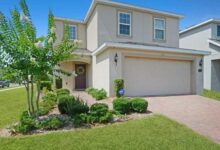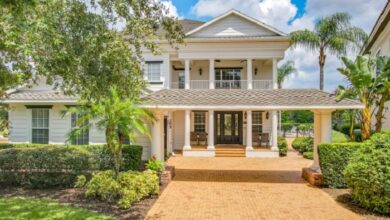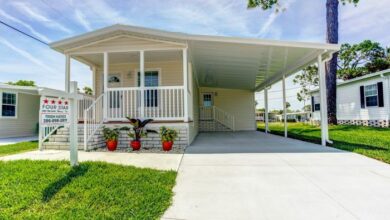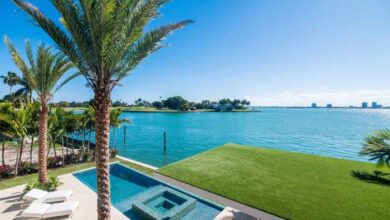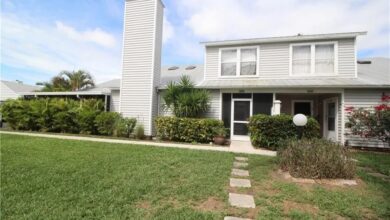New construction homes for sale in Florida under $300k
Finding your dream home in Florida shouldn’t break the bank. This guide explores the exciting world of new construction homes priced under $300,000 in the Sunshine State. We’ll delve into market trends, desirable locations, typical features, financing options, and potential challenges, empowering you to make informed decisions throughout your home-buying journey. Whether you envision a cozy coastal cottage or a spacious family home, we’ll help you navigate the path to owning a piece of Florida paradise within your budget.
From understanding the current market dynamics and comparing new construction to resale options, to exploring financing strategies and navigating the purchasing process, this comprehensive guide provides a wealth of information. We’ll also discuss the importance of thorough inspections and highlight the lifestyle considerations associated with different Florida communities offering homes in this price range. By the end, you’ll be well-equipped to confidently embark on your search for the perfect new home.
Market Overview
The Florida housing market, particularly for new construction homes priced under $300,000, presents a dynamic landscape influenced by factors such as population growth, land availability, and construction costs. While finding a brand new home in this price range requires diligent searching, opportunities exist, especially in specific areas. Competition remains relatively high, driven by both first-time homebuyers and investors, creating a market where quick decision-making is often advantageous.
The availability of new construction homes under $300,000 fluctuates depending on location and time of year. Builders often adjust pricing based on material costs and market demand. Understanding the current trends and regional variations is crucial for prospective buyers.
Geographic Areas with High Concentrations of New Homes Under $300,000
The following table highlights three key geographic areas in Florida where new construction homes under $300,000 are more commonly found. Note that prices and home sizes are averages and can vary significantly based on specific location, lot size, and features within each area. These figures are based on recent market data and may not reflect real-time fluctuations.
| Area | Average Price | Typical Home Size (sq ft) | Notes |
|---|---|---|---|
| Ocala/Marion County | $275,000 | 1,800 | Offers a mix of suburban and rural settings with a lower cost of living compared to coastal areas. |
| Lakeland/Polk County | $290,000 | 1,650 | Located in central Florida, provides relatively affordable options with proximity to larger cities. |
| Sebring/Highlands County | $260,000 | 1,700 | Known for its more rural character and slower pace of life, attracting buyers seeking affordability and tranquility. |
New Construction vs. Resale Homes: Advantages and Disadvantages
Choosing between a new construction and a resale home under $300,000 involves careful consideration of several factors. Each option presents unique benefits and drawbacks.
New construction homes typically offer modern amenities, updated systems (plumbing, electrical, HVAC), and a warranty covering potential defects. However, they may have limited customization options after the initial build and can sometimes have higher upfront costs. Resale homes often offer more established neighborhoods, mature landscaping, and potentially lower purchase prices. Conversely, they may require immediate repairs and renovations, and lack the energy efficiency and modern features of a new build.
The overall value proposition depends heavily on individual priorities and financial circumstances.
Home Features and Amenities
Finding a new construction home in Florida under $300,000 presents exciting opportunities, but it’s important to understand the typical features and potential compromises involved. This price point often necessitates careful consideration of size, location, and specific amenities. Buyers should have realistic expectations and a clear understanding of their priorities.Homes in this price range generally offer a solid foundation, but luxury features might be limited.
Understanding what’s typical and what might require compromise is key to a successful home search.
Typical Features and Amenities
New construction homes priced under $300,000 in Florida typically include functional and modern features, though the specific inclusions can vary greatly depending on the builder and location. These homes are designed for practicality and affordability, often prioritizing essential elements over high-end luxuries.
- Open-concept floor plans: maximizing space and natural light.
- Standard kitchen appliances: typically including a refrigerator, oven, microwave, and dishwasher.
- Laminate or vinyl flooring: durable and easy-to-maintain options in high-traffic areas.
- Basic countertops: often laminate or a less expensive form of granite or quartz.
- Energy-efficient windows and doors: helping to reduce utility costs.
- Central air conditioning: a necessity in Florida’s climate.
- Two or three bedrooms and one or two bathrooms: depending on the size of the home.
- Attached garage (single or double): providing secure parking and storage.
- Landscaping: basic landscaping is usually included, though extensive landscaping may be an added cost.
Common Compromises
To stay within the $300,000 budget, buyers often need to make compromises in several areas. Understanding these trade-offs is crucial for managing expectations and finding a home that meets the most important needs.
- Size: Homes in this price range are generally smaller than those in higher price brackets. Expect less square footage and potentially fewer bedrooms and bathrooms than a luxury home. For example, a three-bedroom home might have smaller bedrooms or a less spacious living area compared to a similar home in a higher price range.
- Location: Prime locations near the coast or in highly desirable neighborhoods typically command higher prices. Buyers may need to consider locations further from major cities or in less developed areas to find homes within their budget. For instance, a home in a rural area might offer more space for the same price as a smaller home in a bustling city center.
- Features: High-end finishes and upgrades, such as custom cabinetry, hardwood floors, and designer fixtures, are less common in homes under $300,000. Buyers may need to forgo these extras or choose more budget-friendly alternatives. For example, laminate flooring might be preferred over hardwood, or standard appliances might replace high-end models.
Energy Efficiency Features and Cost Savings
Many new construction homes in this price range incorporate energy-efficient features to reduce utility costs. These features not only benefit the environment but also provide long-term savings for homeowners.
- High-efficiency HVAC systems: These systems use less energy to heat and cool the home, resulting in lower energy bills. A home with a SEER rating of 16 or higher, for example, will be significantly more efficient than older systems.
- Insulation: Proper insulation helps to maintain a consistent temperature inside the home, reducing the workload on the HVAC system. Adequate insulation can lead to significant energy savings over the lifetime of the home.
- Energy-efficient windows and doors: These features prevent heat loss in the winter and heat gain in the summer, minimizing the energy required for climate control. Windows with low-E coatings, for example, can significantly reduce energy consumption.
- LED lighting: LED lights use significantly less energy than traditional incandescent bulbs, resulting in lower electricity bills. Switching to LED lighting is a simple and cost-effective way to improve energy efficiency.
Financing and Purchasing Process

Purchasing a new construction home in Florida, especially one under $300,000, involves a series of steps and requires careful financial planning. Understanding the process and associated costs is crucial for a smooth and successful transaction. This section Artikels the typical steps, financing options, and common closing costs.
Financing Options for New Construction Homes
Securing financing is a critical first step. Several options are available to prospective buyers, each with its own advantages and disadvantages. Common options include conventional loans, FHA loans, and VA loans. Conventional loans are offered by private lenders and typically require a higher credit score and down payment. FHA loans are backed by the Federal Housing Administration and often have more lenient credit requirements, allowing for lower down payments.
VA loans are available to eligible veterans and active-duty military personnel, often requiring no down payment. It’s advisable to shop around and compare rates from multiple lenders to find the best financing option that aligns with your financial profile. Pre-approval is highly recommended before actively searching for a home to provide certainty regarding your purchasing power.
Steps Involved in Purchasing a New Construction Home
The process of buying a new construction home differs slightly from purchasing an existing home. Typically, the steps include: finding a home and builder, making an offer, securing financing, conducting inspections (often limited in scope for new construction), finalizing the loan, and closing on the property. During the construction process, you’ll likely have several opportunities to review plans and make selections, such as flooring and fixtures.
Regular communication with the builder is key to staying informed about the progress and addressing any potential concerns. Timelines vary depending on the builder and the complexity of the project.
Common Closing Costs for New Construction Homes
Closing costs in Florida for new construction can vary but generally include several key components. These costs are typically paid at the closing of the transaction and can add a significant amount to the overall purchase price. Examples include loan origination fees, appraisal fees, title insurance, recording fees, and homeowner’s insurance. Additionally, property taxes and other local fees might be due at closing.
It’s important to receive a detailed closing cost disclosure from the lender and builder well in advance of the closing date to ensure you are fully prepared for all expenses. Negotiating some closing costs with the builder is sometimes possible.
Sample Budget for a New Construction Home Under $300,000
Creating a realistic budget is essential before embarking on the home-buying process. The following is a sample budget, and actual costs may vary depending on location, home features, and lender:
| Cost Item | Estimated Cost |
|---|---|
| Purchase Price | $280,000 |
| Down Payment (20%) | $56,000 |
| Closing Costs (estimated 3-5% of purchase price) | $8,400 – $14,000 |
| Homeowner’s Insurance (annual) | $1,500 |
| Property Taxes (annual, estimated) | $3,000 |
| Moving Expenses | $2,000 |
| Unexpected Costs (buffer) | $5,000 |
| Total Estimated Cost | $155,900 – $170,900 |
Note: This is a sample budget and actual costs may vary significantly. It is crucial to obtain detailed cost estimates from your lender and builder.
Potential Challenges and Considerations
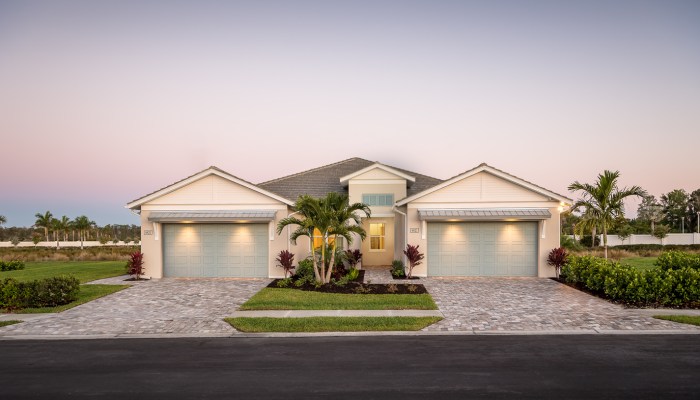
Purchasing a new construction home, especially in a competitive market like Florida, presents unique challenges, particularly within a specific budget. While the prospect of owning a brand-new home is exciting, buyers should be aware of potential hurdles to ensure a smooth and successful transaction. Careful planning and informed decision-making are crucial to mitigate these risks.Finding a new construction home in Florida under $300,000 can be difficult due to high demand and limited inventory in many desirable areas.
Construction delays are also a common occurrence, often stemming from material shortages, labor issues, or unforeseen circumstances. Understanding these potential challenges and proactively addressing them is key to a positive buying experience.
Limited Availability and High Demand
The combination of a growing population and relatively constrained supply of affordable new construction homes in Florida creates a highly competitive market. Buyers may find themselves facing multiple offers on desirable properties, potentially leading to bidding wars or the need to compromise on location, features, or timeline. For example, a highly sought-after community near a major employment center might have only a limited number of homes available in the under-$300,000 price range, resulting in intense competition among buyers.
This necessitates a proactive approach, including pre-approval for a mortgage and being ready to act swiftly when a suitable property becomes available.
Construction Delays and Unexpected Costs
Construction delays are a common occurrence in the new home building process. These delays can stem from various factors, including inclement weather, material shortages, supply chain disruptions, and unforeseen site conditions. For instance, a hurricane could significantly delay the completion of a project, pushing back the closing date and potentially impacting the buyer’s moving plans. Furthermore, unexpected cost overruns can occur, requiring the buyer to either absorb additional expenses or renegotiate the purchase agreement.
Thorough due diligence, including researching the builder’s reputation and track record, can help mitigate this risk.
Working with Builders and Contractors
Effective communication and a well-defined contract are essential when working with builders and contractors. Maintaining open lines of communication throughout the construction process helps address concerns promptly and prevent misunderstandings. The purchase agreement should clearly Artikel all aspects of the construction, including timelines, specifications, and payment schedules. Regular site visits allow buyers to monitor progress and identify potential issues early on.
Buyers should also be prepared to advocate for themselves and address any concerns they have with the builder or contractor promptly and professionally. Seeking legal advice before signing any contract is strongly recommended.
Importance of Thorough Home Inspections
A thorough home inspection before closing is crucial to identify any potential defects or issues with the new construction home. While new homes are expected to be free from significant problems, minor defects can still occur during the construction process. An independent inspection by a qualified professional helps uncover these issues before the buyer assumes ownership, allowing for necessary repairs or adjustments to be made before closing.
This preemptive step can save the buyer significant time, money, and stress in the long run. The inspection report should be carefully reviewed and any identified issues should be addressed with the builder before finalizing the purchase.
Lifestyle and Community Aspects

Finding a new construction home in Florida under $300,000 often means exploring communities that offer a blend of affordability and desirable lifestyle elements. These areas typically cater to a diverse population, including young families, retirees, and working professionals seeking a more budget-friendly entry into the Florida real estate market. Understanding the nuances of these communities is crucial for prospective buyers.The lifestyle associated with these communities varies significantly depending on location.
While some areas might offer a more suburban feel with a focus on family-friendly amenities, others might present a more urban or even rural atmosphere, depending on proximity to larger cities and the overall development style. Careful consideration of these variations is vital in choosing a community that aligns with individual preferences and needs.
Community Location and its Impact on Lifestyle
The location of a community significantly influences the overall lifestyle. For instance, communities near major cities like Orlando or Tampa might offer easy access to employment opportunities, entertainment venues, and cultural attractions, but could also come with higher costs of living outside of the home price itself, increased traffic congestion, and a more densely populated environment. Conversely, more rural areas further from major urban centers often provide a quieter, more nature-oriented lifestyle, but may require longer commutes and limited access to certain amenities and services.
Coastal communities, while offering beach access, can be more expensive and prone to hurricane risks. Interior communities might offer more affordability and tranquility but may lack the immediate access to coastal amenities.
Factors to Consider When Evaluating a Community
Before making a purchase decision, prospective buyers should carefully assess several key community characteristics. This includes considering the quality of local schools, if applicable, the availability of nearby healthcare facilities, the proximity to employment centers and daily conveniences like grocery stores and pharmacies, the overall safety and crime rates of the area, the presence of recreational amenities such as parks, trails, and community centers, the availability of public transportation, and the overall aesthetic appeal and sense of community within the neighborhood.
Reviewing online community forums and local news reports can provide additional insights into the daily life and character of the area.
Comparing Advantages and Disadvantages of Different Regions
A comparison of different regions highlights the varied lifestyle offerings. For example, communities in Central Florida, while often more affordable, might experience higher temperatures and humidity than those in North Florida. Communities in Southwest Florida offer proximity to beaches, but may face higher property insurance costs due to hurricane risk. North Florida communities often boast a more temperate climate and a slower pace of life, but may have fewer job opportunities in certain sectors compared to South Florida.
Ultimately, the “best” region depends entirely on the buyer’s individual priorities and preferences.
Illustrative Examples
Finding a new construction home in Florida under $300,000 requires careful consideration of location and features. While options may be limited in some highly desirable areas, several regions offer attractive possibilities for budget-conscious buyers. This section provides examples of what you might find.
To illustrate the variety available, we’ll examine typical new construction homes in Ocala, Florida, a city known for its affordable housing and proximity to nature.
A Typical New Construction Home in Ocala, Florida
Imagine a three-bedroom, two-bathroom home nestled in a quiet Ocala neighborhood. The exterior might feature a classic Florida style with stucco siding and a tiled roof, designed for durability in the subtropical climate. The front yard, perhaps landscaped with native drought-tolerant plants, provides curb appeal without demanding excessive maintenance. Inside, the open-concept living area seamlessly connects the kitchen, dining, and family room, creating a spacious feel.
The kitchen boasts modern appliances, granite countertops, and ample cabinet space. The master suite includes a walk-in closet and a private bathroom with a shower/tub combo. The remaining two bedrooms are well-sized and share a full bathroom. A covered lanai extends the living space outdoors, perfect for enjoying Florida’s pleasant weather. The home likely includes a one-car garage and a fenced backyard, providing both security and privacy.
This example showcases a balance of affordability and desirable features, common in new construction homes in Ocala within the specified price range.
Floor Plan Maximizing Space in a Smaller Home
This design prioritizes efficient use of space within a smaller footprint, perhaps around 1,200 square feet. The emphasis is on maximizing functionality without sacrificing comfort.
The layout features an open-plan living area, with the kitchen cleverly integrated into the main space to create a feeling of spaciousness. A breakfast bar separates the kitchen from the living and dining area, acting as both a counter and a casual dining spot. Two bedrooms share a bathroom, with the master bedroom positioned for privacy at the rear of the home.
Built-in storage solutions, such as custom shelving and closets, further enhance space utilization. A small, but well-designed, laundry area is tucked away discreetly, maintaining a clutter-free environment. While outdoor space may be more limited, a small patio or balcony might be included, still providing an area for relaxation.
Floor Plan Prioritizing Outdoor Living Space
This plan, perhaps spanning 1,500 square feet, prioritizes outdoor living. The design incorporates expansive windows and sliding glass doors that seamlessly connect the interior to a large patio or lanai. The kitchen and dining areas are strategically positioned to maximize the view and access to the outdoor space, encouraging indoor-outdoor living. The master suite is also oriented towards the outdoor area, providing direct access to the patio from the bedroom.
A screened-in porch or covered lanai provides protection from the elements while allowing for year-round enjoyment of the outdoors. The remaining bedrooms are situated for privacy, away from the main living area and outdoor space. The overall design emphasizes the fluidity between indoor and outdoor spaces, creating a home perfectly suited for Florida’s climate.
Purchasing a new construction home under $300,000 in Florida presents a unique opportunity to build a future filled with sunshine and affordability. While challenges exist, careful planning, thorough research, and a strategic approach can pave the way for a successful home-buying experience. Remember to prioritize your needs, thoroughly investigate potential locations and builders, and secure the right financing to make your Florida dream a reality.
With diligent preparation and the right guidance, you can confidently navigate this exciting process and find the perfect home to call your own.
Key Questions Answered
What are common HOA fees in these communities?
HOA fees vary significantly depending on the community. Expect to research individual community fees as they can range from a few hundred to over a thousand dollars annually.
How long does the construction process typically take?
Construction timelines vary based on the builder, size of the home, and current market conditions. Expect delays and allow extra time beyond the builder’s initial estimate.
What are the property taxes like in these areas?
Property taxes in Florida are relatively low compared to some other states, but they vary by county and assessed value. It’s crucial to factor property taxes into your budget.
Are there any specific building codes or regulations I should be aware of?
Yes, Florida has specific building codes and regulations. It’s essential to work with a builder who is fully compliant with all local, state, and national building codes.
Can I customize the floor plan of a new construction home?
Customization options vary by builder. Some builders offer a degree of customization, while others have fixed floor plans. Inquire about customization options early in the process.
